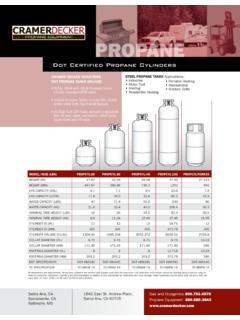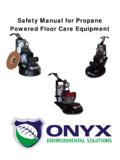Transcription of HSE APPROVED SPECIFICATION Specification DOT …
1 ISSUE 1. HSE APPROVED SPECIFICATION . SPECIFICATION DOT-4BA(HSE). Welded steel cylinders made of definitely prescribed steels January 1997. i\:THSDA5\HARRY\CYL\4 BASPEC2. ISSUE 1. Contents 1. Type, size and service pressure. 2. Certificate of compliance 3. Duties of inspector 4. Authorised steel 5. Identification of material 6. Defects 7. Manufacture 8. Welding of attachments 9. Wall thickness 10. Heat treatment 11. Openings in cylinders 12. Safety relief devices and protection for valves etc. 13. Hydrostatic test 14. Physical test. 15. Elongation. 16. Test of welds. 17. Rejected cylinders 18. Marking 19. Report retention 1. i\:THSDA5\HARRY\CYL\4 BASPEC2. ISSUE 1. 1. Type, size and service pressure. Cylinders may be spherical or cylindrical in shape. Closures made by the spinning process are not authorised.
2 Spherical type cylinders must be made from two seamless hemispheres joined by the welding of one circumferential seam. Cylindrical type cylinders must be of circumferentially welded construction. The capacity of the cylinder must not exceed 454 kg (1000 pounds) water capacity (nominal). Service pressure at least Bar g (225 ) and not over Bar g (500. ). Developed pressure of the contents according to BS 5355 must not exceed the test pressure. 2. Certificate of compliance The Inspection Body APPROVED by the HSE shall certify that the manufacture, inspection and testing of the cylinders was carried out in compliance with the requirements of this SPECIFICATION . Note: A suitable form of certificate is shown in Appendix 1. 3. Duties of inspector Inspect all material and reject any not complying with requirements of this SPECIFICATION .
3 Verify chemical analysis of each heat of materials by analysis or by obtaining certified analysis: Provided, that a certificate from the manufacturer thereof, giving sufficient data to indicate compliance with requirements is acceptable when verified by check analyses of samples, taken from one cylinder out of each lot of 200 or less. Verify compliance of cylinders with SPECIFICATION requirements including: markings;. condition of inside; tests; threads; heat treatment. Obtain samples for all tests, and check chemical analysis, witness all tests; report volumetric capacity, tare weight (see report form). and minimum thickness of wall noted and recorded. Furnish complete test reports required by this SPECIFICATION to the maker of the cylinder and, upon request, to the purchaser. The test report shall be retained by the inspector for fifteen years from the original test date of the cylinder .
4 2. i\:THSDA5\HARRY\CYL\4 BASPEC2. ISSUE 1. 4. Authorised steel Table I. Designation Chemical composition, percent-ladle analysis Grade 1 (1) Grade 2 (12) Grade 3 (245). Carbon maximum maximum Manganese maximum Phosphorus, (6). maximum Sulphur, maximum Silicon maximum Copper, maximum Niobium 3. Heat treatment () (3) (3). authorised Maximum stress 240 240 240. (N/mm2). 1 Addition of other elements to obtain alloying effect is not authorised. 2 Ferritic grain size 6 or finer according to ASTM E112-63. 3 Any suitable heat treatment in excess of 593oC (1100oF), except that liquid quenching is not permitted. 4 Other alloying elements may be added and shall be reported. 5 For compositions with a maximum carbon content of % of ladle analysis, the maximum limit for manganese on ladle analysis may be 6 Rephosphorized Grade 3 steels containing no more than phosphorus are permitted if carbon content does not exceed and manganese does not exceed 1%.
5 3. i\:THSDA5\HARRY\CYL\4 BASPEC2. ISSUE 1. Check analysis tolerance. [A heat of steel made under any of the above grades, the ladle analysis of which is slightly out of the specified range is acceptable if the check analysis is within the following variation:]. Element Limit or maximum Tolerance (%) over the maximum limit or specified (%) under the minimum limit Under minimum limit Over maximum limit Carbon To inclusive Over to inclusive Manganese To inclusive Over to inclusive Over to inclusive Phosphorus7 All ranges Sulphur All ranges Silicon To inclusive Over to inclusive Copper To inclusive Over to inclusive Nickel To inclusive Over to inclusive Chromium To inclusive Over to inclusive Molybdenum To inclusive Over to inclusive Zirconium All ranges Niobium To inclusive Aluminium Over to inclusive Over to inclusive 7.
6 Rephosphorized steel not subject to check analysis for phosphorus. 5. Identification of material 4. i\:THSDA5\HARRY\CYL\4 BASPEC2. ISSUE 1. (a) Any suitable method except that plates and billets for hot drawn cylinders shall be marked with the heat number. 6. Defects Material with seams, cracks, laminations or other detrimental defects, not authorised. 7. Manufacture By suitable appliances and methods; dirt and scale to be removed as necessary to afford proper inspection; no defect acceptable that is likely to weaken the finished cylinder appreciably; reasonably smooth and uniform surface required. Exposed bottom welds on cylinders over 460 mm (18 inches) long shall be protected by footrings. Minimum thickness of heads shall be not less than 90 percent of the required thickness of the side wall.
7 Circumferential seams are by welding. Longitudinal seams in heads not permitted. Welding procedures and operators shall be qualified in accordance with CGA Pamphlet C-3. 8. Welding of attachments The attachment to the tops and bottoms only of cylinders by welding of neckrings, footrings, handles, bosses, pads and valve protection rings is authorised provided that such attachments and the portion of the container to which they are attached are made of weldable steel, the carbon content of which shall not exceed percent. 9. Wall thickness For outside diameters over 150 mm (6 inches) the minimum wall thickness shall be 2. mm ( inch). In any case the minimum wall thickness shall be such that the calculated wall stress at minimum test pressure shall not exceed the lesser value of any of the following: (1) The value shown in Table I, for the particular material under consideration.
8 (2) One-half of the minimum tensile strength of the material determined as required in section 14. The measured wall thickness shall not include galvanising or other protective coating. Cylinders that are cylindrical in shape must have the wall stress calculated by the formula: S = [P ( + )] / (D2 - d2). 5. i\:THSDA5\HARRY\CYL\4 BASPEC2. ISSUE 1. S = wall stress, N/mm2 ( ), P = minimum test pressure prescribed for water jacket test, N/mm2 ( ). D = outside diameter, mm (inches), d = inside diameter, mm (inches), Cylinders that are spherical in shape must have the wall stress calculated by the formula: S=PD/4tE. Where: S = wall stress N/mm2 ( ), P = minimum test pressure prescribed for water jacket test;N/mm2 ( ), D = outside diameter mm (inches), t = minimum wall thickness mm (inches), E= (provides 85 per cent weld efficiency factor which must be applied in the girth weld area and heat affected zones which zone shall extend a distance of 6 times wall thickness from centre line of weld).
9 E = (for all other areas). For a cylinder with a wall thickness less than mm ( inch), the ratio of tangential length to outside diameter shall not exceed 4:1. 10. Heat treatment Each cylinder shall be uniformly and properly heat treated prior to test by the applicable method shown in Table 1. Heat treatment shall be accomplished after all forming and welding operations. Heat treatment is not required after welding weldable low carbon parts to attachments of similar material which have been previously welded to the top or bottom of cylinders and properly heat treated, provided such subsequent welding does not produce a temperature in excess of 205oC (400oF) in any part of the top or bottom material. 11. Openings in cylinders Any opening must be placed on other than a cylindrical surface.
10 Each opening in a spherical type cylinder must be provided with a fitting, boss, or pad of weldable steel securely attached to the container by fusion welding. Each opening in a cylindrical type cylinder must be provided with a fitting, boss, or pad, securely attached to container by welding. If threads are used, they must comply with the following: (a) Threads must be clean-cut, even, without checks and tapped to gauge. 6. i\:THSDA5\HARRY\CYL\4 BASPEC2. ISSUE 1. (b) Taper threads to be of length not less than as specified for American Standard taper pipe threads. (c) Straight threads, having at least 4 engaged threads, to have tight fit and calculated shear strength at least 10 times the test pressure of the cylinder ; gaskets required, adequate to prevent leakage. 12. Safety relief devices and protection for valves, safety devices and other connections, if applied General Requirements No pressure relief device shall be fitted to a container intended for the conveyance of toxic gases, but a pressure relief device may be fitted to a container intended for the conveyance of non-toxic gases.












